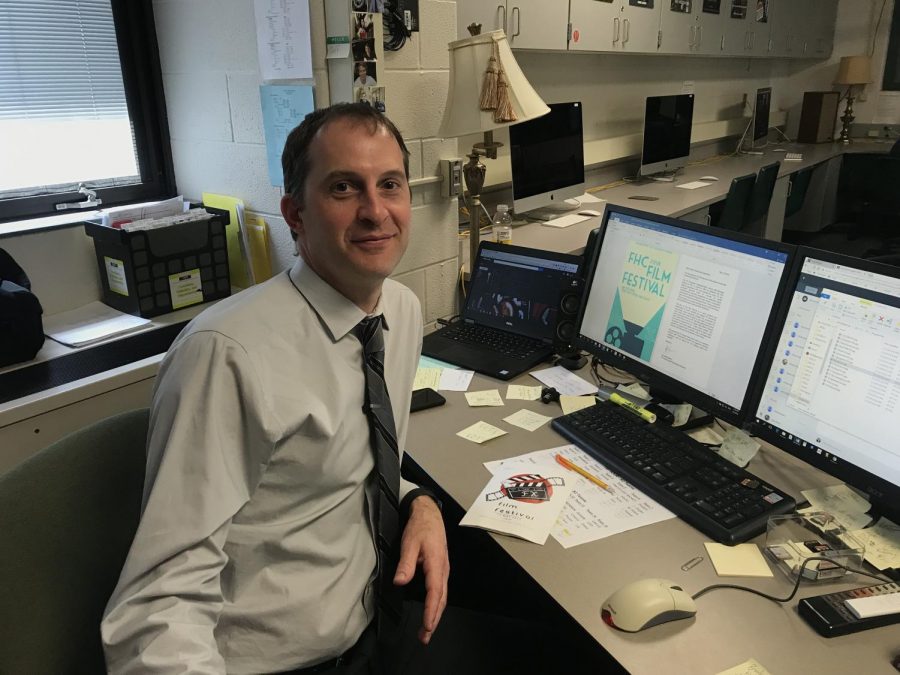Jeff Manders Film Festival Q&A
Irene Yi, Staff Writer
1. How is FilmFest structured?
“There are fifteen films this year; there are four different theaters. It’s like a regular film festival, where there are multiple films playing at the same time. There will be four different films playing at once, and each film will be played twice. Every twenty minutes or so, the venues will pop open. People will run around and try to go see one of the other films. You can see up to eight of the fifteen during the festival, so you have to pick and choose which ones you want to see. One of the venues will be in my room, Room 116. [Another one] is across the hall from me; we open up the wall, so it’ll be a double venue, and the film will be showing on two screens. The lecture hall is another venue, and this year we’re trying to turn Room 110 and 112 into another double venue.”
2. How many people come to FilmFest?
“We had so many people here last year. We ordered about 400 programs last year, and we ran out in no time. There were more than 400 people here last year. Some of the venues are just packed; there will be people stacked on top of people, people pressed against the walls, people laying on each other, all that.”
3. When did the students start working on their projects?
“We started this project in September. They started with planning, so they get the assignment and come up with a general idea–kind of what the overall message of their story will be. They write the screenplay, and that’s their midterm exam grade. Then they have to cast it and plan. They have to make film posters and trailers, and I’m working on the programs right now. In January, they’re supposed to start filming, and everything is supposed to be filmed by spring break. Obviously, they aren’t done, so now they’re scrambling to film.”
4. What do FX students gain from this experience?
“What’s cool about to the festival itself is that it’s open to the public. I send an invite to parents and more. You’re showing your movie to ten or twelve of the kids that you know, but the room is packed with a hundred people–a hundred strangers. It’s just such a real-life experience for them. We have such a tight focus on what we do with FX; just like The Central Trend, we cover school news and stuff. But they also want to be crazy in their own ways with film, so [Film Festival] is kind of creating an outlet for all that creative energy. Normal films about school events are about a minute. These ones are about fifteen, so they’re way more involved. They’re working all year on this crazy, extravagant story they’re telling. Most of them are getting very close to being done.”
5. How did Film Festival start?
“It was started before me, so Mrs. Leighton who was here did it before. The earliest poster I could find is around 2000. She started it; actually, I think she did it even before that. She was a big film buff, so I’ve just been continuing what she’s doing. They work in groups of three. and they get each other to help out. They do all the directing and writing–and usually, they raid the theater department for who gets to be in it and stuff.”
6. What is your proudest moment on the journey of Film Festival?
“Proudest moment? If they all get them done on time, I will be very proud.”
“But really, seeing all this creative energy and planning is rewarding. Some of these groups have really planned these out and worked really hard on them. Their vision on it grows: from their story to their script to their screenplay, it has all come out as these beautiful things. Films can really be a piece of art. When the kids really put the time and effort into them, and when they really care, the reward is so much greater. Everyone’s adrenaline levels are through the roof when we’re done at the end of the night.”
7. What would you say to someone who was considering coming out to see it?
“I think they should come out and see some of the creativity of these students–and what they can pull off. I think they’ll be really impressed. Some of them come off as professional films. They’re really entertaining; there are comedy films, serious ones, and some that are really dark. There are ones that challenge the way you look at things. There’s such a variety, so I think there’s something for everyone.”
The Central Trend • Copyright 2025 • FLEX WordPress Theme by SNO • Log in
